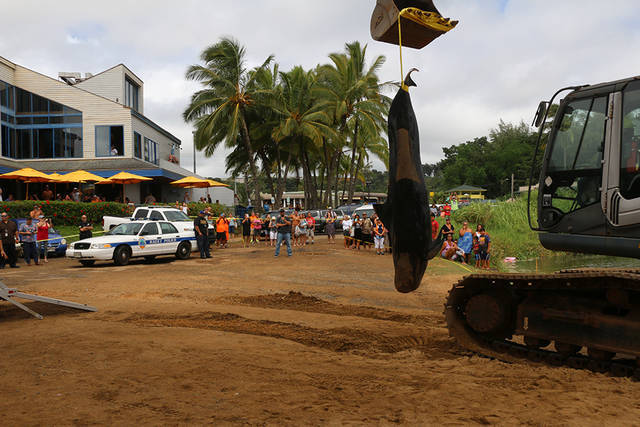In the early morning hours of Oct 13, a heartbreaking and highly unusual mass stranding of pilot whales occurred at Kalapaki Beach on Kaua‘i. Soon after, social media was abuzz with photos and video taken from residents and tourists of the island. NOAA (National Oceanographic and Atmospheric Administration), DLNR (Hawaii’s Department of Land and Natural Resources), the U.S. Coast Guard, Hawaiian cultural practitioners, and community residents responded to the stranding, working together to guide the struggling whales back out to sea.
According to this story, the initial whale death toll was three. Later that afternoon, the whales began stranding themselves again. Two more whales died, bringing the total number of dead pilot whales to five.
NOAA has opened an investigation to determine the possible causes of this rare, mass mortality event. According to reports, we may not have the answer for several weeks or longer. Many residents suspect that military sonar testing played a role, as this has been a controversial practice and the subject of litigation in the past.
At this early stage, from a standpoint of scientific inquiry, other factors cannot be ruled out. Other events and proximate operations must also be considered by the state and federal agencies. This includes the 11.5 tons of the anticoagulant rodenticide, diphacinone, that was aerially dropped from helicopters on the island of Lehua over the last two months, which is located just west of Kaua‘i.
You can read more about the Lehua aerial poison drop here, and specifically, this letter from the EPA outlining their concerns for the project.
Eyewitness accounts at the stranding site indicate at least one of the whales showed signs of hemorrhaging in the head area, and reports on social media indicated that some of the whales were bleeding from their eyes and ears. According to published research, sonar testing can cause cetaceans to become disoriented and deaf, in addition to showing signs of bleeding in the cranial region. The Navy has stated there was no sonar testing occurring in the area at the time.
Anticoagulant rodenticides such as diphacinone also cause hemorrhaging, because they interfere with the blood’s natural clotting ability. Hemorrhaging, confusion, loss of consciousness, and seizures are classic symptoms of exposure to anticoagulant rodenticides.
Testing and a rigorous study protocol would be an attempt to understand any possible interplay among environmental factors causing the whale deaths. Could whales exposed to diphacinone through eating poisoned fish (or direct ingestion of the poison bait pellets) become weakened and more susceptible to any additional stresses, such as sonar testing or disease? (Reports on social media from the veterinarian onsite indicate that fish bones were found in whale stomach contents.) Or could exposure to sonar impact the whales’ ability to withstand even non-lethal doses of diphacinone? A thoughtful and conscientious testing protocol for the lowest traceable amounts of diphacinone in the whale livers and tissues would begin to answer these questions.

Dead pilot whale being removed from Kalapaki Beach.
What is disturbing is the immediate issuance of a press release from DLNR denying any connection to the Lehua poison drop from the private, sole-source contractor that carried out the project, Island Conservation. From this press release published by DLNR:
Gregg Howald, Director of Global and External Affairs for Island Conservation, the organization that led recent rat eradication efforts—“We know, with the highest degree of confidence that the Lehua Restoration Project and the rodenticides applied in that project have virtually no chance of contributing to the whales’ demise; The likelihood of any impact to pilot whales is so unlikely, it is bordering on the impossible.”
To make such a statement, without the benefit of any actual test results or completed necropsies, contravenes any standard of science-based discipline and scientific integrity.
What cannot be overlooked are the whale deaths in Hawai’i that soon followed all three “over water” aerial applications of anticoagulant rodenticides done in Hawai’i (Mokapu, near Maui in 2008, and two whale deaths in 2009 following the 2009 Lehua drop), all in the name of conservation. All whale strandings occurred within a month (give or take a few days) following an aerial poison drop.
Timeline of Aerial Poison Drops and Whale Deaths
- Mokapu Island 2008: Aerial poison drops of diphacinone were carried out on February 6 and 12. On February 25, a whale beached itself on Maui.
- Lehua Island 2009: Aerial poison drops of 3,900 lbs. of diphacinone occurred on January 6 and 13. Whale mortalities were reported on Ni‘ihau on January 21, and at a beach in Kekaha (Kaua‘i) on February 9. A mass fish die-off of reef fish was also reported on Ni‘ihau on January 17.
- Lehua Island 2017: Three aerial poison drops, totaling 11.5 tons of diphacinone were carried out on August 23 and 30, and again on September 12. A pod of pilot whales beached themselves on the south shore of Kaua‘i on October 13, resulting in five whale deaths.
You can read more about previous aerial poison drops in Hawai’i in this presentation delivered during a regional pesticides conference.
Following the 2009 whale deaths after the first Lehua poison drop, no in-depth testing for rodenticide impact was made by DLNR or USFWS to investigate any of the following:
- Sub-lethal levels of diphacinone in liver tissues, where diphacinone persists over an extended period.
- Confirmation of stomach contents of the dead whales that might have indicated ingestion of poisoned fish or poison bait.
- Presence of blood clotting factors that could indicate whale exposure to diphacinone.
- Any inquiry about contributing factors that may have lowered the ability to withstand sub-lethal doses of diphacinone.
Background on Lehua Aerial Poison Drop—Video of Fish and Bird Deaths
On August 23, despite local opposition from community residents and a request from Hawai’i State Representative Dee Morikawa to hold off on the Lehua poison drop, USFWS, DLNR and Island Conservation began the first of three helicopter poison drops over the 284 acre wildlife sanctuary.
On September 3, four days after the second aerial poison drop was carried out by Island Conservation, a grim discovery was made of dead fish, birds, and rat poison pellets floating in the water on the north side of the island. This video was shot by a resident of Kaua’i who prefers to remain anonymous.
After photos and video began circulating on social media, DNLR sent a monitoring team out to collect samples. According to reports, 45 dead mullets and two pelagic birds (brown boobies) were gathered and sent off for testing, though this conceivably represents only a portion of the total die-off, as what you visually see in wildlife mortality events often represents a mere fraction of the true mortality that is occurring (Wobeser 1992).
According to a statement issued by DNLR, the animals were going to be tested for the presence of diphacinone, the rodenticide used in the aerial rat poison drop, though no specifics were provided regarding tissue types or levels of detection to be used.
Without taking the time to understand the cause of the fish and bird deaths, and despite a second request from Hawai‘i State Representative Dee Morikawa to postpone the third and final poison drop, USFWS, DLNR and Island Conservation steamrolled ahead with the third aerial drop on Sept 12. No prior notification was given to the community that this last drop was occurring.
USFWS and DLNR had stated during local public consultation meetings that a fishing ban was possible, and in email correspondence from USFWS, that a 30-day fishing ban would be implemented after the drop to ensure that no surviving fish contained any residual contamination.
The fishing ban was never implemented, and the subsistence fisherman on the neighboring island of Ni‘ihau, located just under a mile away, continued to fish and gather opihi (limpets) to feed their families, immediately following the poison drop. One has to ask the question—Why didn’t the Hawai‘i Department of Health follow up with any cautionary statements or signs for local fishermen and boaters about fishing or entering Lehua waters?
Six weeks have passed since the fish and birds were collected, and the test results to determine the cause of bird and fish deaths have yet to be released to the public. Based on experience with major wildlife rehabilitation centers that routinely test deceased wildlife suspected of secondary poisoning, the turnaround time for an anticoagulant screen (the test used to determine the presence of anticoagulant rodenticides) is normally five to six working days.
The lack of such results over a month after specimens were collected is inexplicable and highly questionable, given the immediate need to know whether diphacinone was implicated in the fish and bird deaths, especially since the surrounding waters are critical habitat for the endangered monk seal.
And DNLR has now hinted, in an article published October 16 by The Garden Island Newspaper, that the fish were possibly “too degraded for them to get the lab results.”
Really? As you can see in the video above, the dead fish and birds appear to be fully intact, and since it is the livers of these animals that will be tested for the presence of diphacinone, which can remain in liver tissue for up to 90 days, one has to question the motives of this statement by DLNR.
Will the Agencies Perform Diphacinone Testing on these Whales—and to the Lowest Level of Detection?
The Environmental Assessment for the Lehua eradication project explicitly did not include any information on diphacinone uptake, exposure levels, or toxicity levels to cetaceans (whales, dolphins and porpoises), citing lack of data. Therefore, right now, a conscientious scientist would be looking for trace amounts of diphacinone in the livers of these dead whales, stomach contents, and other tissues. Blood would be tested for clotting factors.
The tragic deaths of these pilot whales provides state and federal agencies a rare and unique opportunity to test the whales for the lowest levels of diphacinone, well below the LD 50 “lethal dose” threshold. The technology exists, and we must make sure that the deaths of these magnificent beings lead to additional knowledge that will further the advancement of science, and possibly prevent a reoccurrence of this tragic event.
I reached out to Hawai’i State Representative Dee Morikawa and asked her thoughts concerning the deaths of the pilot whales and the current investigation:
“The deaths of the pilot whales was a tragedy that I was hoping would not happen, especially after my attempts to slow down the aerial rodenticide application on Lehua Island. The rodenticide got into the ocean. Fish and birds died, and now whales. The same thing happened after the rodenticide drop in 2009. Some are placing the blame on military sonar activities, but if that was the case, why haven't we seen more incidences from 2009 until now? The only common occurrence for the deaths in 2009 and now, were the aerial drops of rodenticide. Only accurate tests, will determine these deaths, and I hope that all results will be made public, so that we can determine whether diphacinone played a role. It is critical to know this, since future aerial eradications are being planned on other islands. There is no doubt that many want to see rats gone, however, the method of aerial application is too sloppy and dangerous.” - Hawai’i State Representative Dee Morikawa, District 16.
